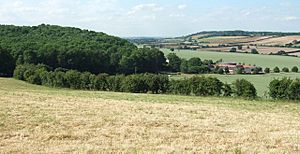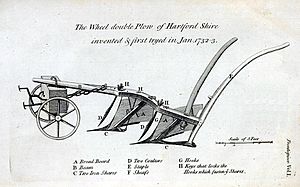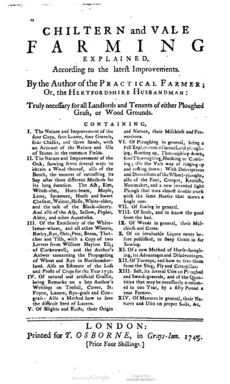William Ellis (writer on agriculture) facts for kids
William Ellis (born around 1700, died 1758) was an English farmer from a village called Little Gaddesden in Hertfordshire. He became well-known for writing many books about farming.
Contents
About William Ellis
William Ellis was born about 1700. He had a normal education and started his life as a simple farmer. For almost 50 years, he worked on a farm in Little Gaddesden, Hertfordshire. He didn't claim to use super scientific methods there. However, he was a smart person and had traveled a lot, both in England and other countries.
His first books made him quite famous. Many landowners from all over the country asked him to visit their farms and give advice. So, he traveled across northern England, sharing his farming knowledge with those who paid for his help.
Ellis was also good at business. He earned extra money by traveling as a seller of seeds and farm tools. He was ready to do any kind of farm-related business for a set price. Many excited farmers, who had heard about his fame and read his books, went to visit Ellis's own farm. But they were surprised and disappointed! They found that he didn't actually use the new ideas he wrote about. His farm tools were old-fashioned, and his land looked neglected and in poor condition.
This news quickly spread and hurt the sales of his books. His books had introduced many new ways to handle animal waste (manure), sheep, turnips, and lucerne (a type of plant). But now, his reputation started to fade. Ellis sadly realized that his fame was disappearing.
His Books and Writings
One of Ellis's books about timber (wood) was very successful. It was printed three times in less than three years! This success led a book publisher named Osborne to hire him as a writer. Ellis then wrote many, many books. He started writing monthly articles and then even bigger books. To fill the pages he promised, he sometimes added funny stories or unnecessary details. These parts made his writings less useful.
When Ellis followed his own rule, "I always thought that real-life experience was the only way to find the truth," his books were valuable. He believed that everything he wrote about should be tested in real farming. But later, the editor of his last book had to remove many silly stories about travelers, thieves, and strange old remedies. These were clearly just put in to fill space. Today, Ellis's books are not very useful because farming science has advanced a lot since his time.
The Practical Farmer, 1732
His book, The Practical Farmer, or the Hertfordshire Husbandman, was first published in 1732. It was about 223 pages long. This book was so popular that it was printed five times, with the last edition coming out in 1759.
It talked about how to improve soil, different types of grains, grasses, cows, sheep, and how to raise calves. It also covered pigeons, rabbits, forest trees, and different kinds of manure. Ellis suggested using a horse to hoe (loosen the soil around) peas and beans. He also thought burnt clay was good for soil. He knew that letting sheep eat turnips directly from the field was very good for light soils.
He wrote that cows could make a profit of £1 a year by feeding fat calves or by producing butter and cheese. Cows could be useful for about ten years. He also wrote about how to treat and cure animal diseases. Ellis believed sheep were the best farm animals. He thought that if a farmer didn't keep sheep, they might not succeed. He said that a common sheep disease called "rot" was caused by water and could be cured with salt and dry food. The book also mentioned fruit trees for farmers and how to make cider and perry (pear cider).
Chiltern and Vale Farming, 1733
Chiltern and Vale Farming explained was a book of about 400 pages. It discussed how to grow crops on heavy clay soils, including common grains and plants like peas and beans. It also covered natural and planted grasses, general ploughing methods, seeds, weeds, and how to prepare seeds. He wrote about horse-hoeing and the use and value of turnips.
The book described a special plough with two mould-boards (parts that turn over the soil). Ellis seemed to really like this plough. However, the way the book was organized was a bit confusing. For example, he talked about planting oak and fruit trees right in the middle of a section about growing crops on fields.
Ellis also described different types of grains and their value. He talked about artificial grasses like white and red clovers, sainfoin, lucerne, ryegrass, and cow-grass (which is a type of clover). He explained different kinds of manure well. He thought that heating lime (a type of rock) made it more useful for the soil. He believed that lime could help all kinds of land. He also thought chalk was excellent for correcting acidity in the soil.
The Modern Husbandman, 1750
This book described the farmer's year, month by month, and general farm management. Many people think this was Ellis's best work. However, it's funny to read a sentence like "Be yourself the first man up in a morning for sounding at your door your harvest horn to call your men at four o'clock." This advice was quite different from how Ellis himself farmed, according to those who visited him at Little Gaddesden!





